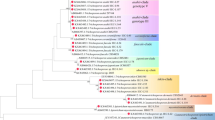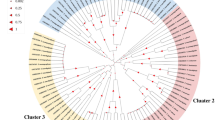Abstract
We screened a total of 460 stool samples from humans with and without underlying disease for the black yeast and neurotrope, Exophiala dermatitidis using conventional and molecular identification procedures. Sixteen (3.5%) samples were positive. Twelve out of the sixteen positive samples where the fungus was recovered were from individuals who had diarrhoea at the moment of isolation. Two asymptomatic positive cases were within the age bracket of 21–30. Susceptibility testing of the strains using the CLSI M38 protocol suggests that almost all the strains were susceptible to amphotericin B, 5 fluorocytosine, itraconazole, fluconazole and voriconazole. Considering the health risk currently posed by this organism in Asia, especially among healthy younger subjects of the population and the scarcity of data on this fungus in Africa in general and Nigeria in particular, some recommendations were suggested.
Similar content being viewed by others
References
De Hoog GS, Matos T, Sudhadham M, Luijsterburg KF, Haase G. Intestinal prevalence of the neutropic black yeast Exophiala (Wangiella) dermatitidis in healthy and impaired individuals. Mycoses. 2005;48:142–5.
De Hoog GS, Zeng JS, Harrak MJ, Sutton DA. Exophiala xenobiotica sp. nov., an opportunistic black yeast inhabiting environments rich in hydrocarbons. Antonie Leeuwenhoek. 2006;90:257–68.
Matos T, Haase G, Gerrits van den Ende AHG, De Hoog GS. Molecular diversity of oligotrophic and neurotropic members of the black yeast genus Exophiala, with accent on E. dermatitidis. Antonie Van Leeuwenhoek. 2003;83:293–303.
Hiruma M, Kawada A, Ohata H, et al. Systemic phaeohyphomycosis caused by Exophiala dermatitidis. Mycoses. 1993;36:1–7.
Matsumoto T, Matsuda T, McGinnis MR, Aiello L. Clinical and mycological spectra of Wangiella dermatitidis infections. Mycoses. 1993;36:145–55.
Chang HL, Kim DS, Park DJ, Kim HJ, Lee CH, Shin HJ. Acute cerebral phaeohyphomycosis due to Wangiella dermatitidis accompanied by cerebrospinal eosinophilia. J Clin Microbiol. 2000;38:1965–6.
Haase G, Skopnik H, Groten T, Kusenbach G, Posselt H-G. Long-term fungal cultures from patients with cystic fibrosis. Mycoses. 1991;34:373–6.
Ajanee N, Alam M, Holmberg K, Khan J. Brain abscess caused by Wangiella dermatitidis: case report. Clin infect Dis. 1996;23:197–8.
Nweze EI, Curs-breuker I, Janssen B, de Hoog GS, Meis JF. In vitro activity of posaconazole compared with other antifungal agents against 95 strains of Exophiala dermatitidis against seven antifungal agents. Proceedings of the 46th interscience conference on antimicrobial agents and chemotherapy, San Fransisco. September 27–30, 2006. pp 420
Fothergill AW, Rinaldi MG, Sutton DA. Antifungal susceptibility testing of Exophiala spp.: a head-to-head comparison of amphotericin B, itraconazole, posaconazole and voriconazole. Med Mycol. 2009;47(1):41–3.
de Hoog GS, Haase G. Nutritional physiology and selective isolation of Exophiala dermatitidis. Antonie Van Leeuwenhoek. 1993;64:17–26.
National Committee for Clinical Laboratory Standards. Reference method for broth dilution susceptibility testing of filamentous fungi: approved standard. NCCLS document M38-A. Wayne, PA: National Committee for Laboratory Clinical Standards; 2002.
Sudhadham M, Prakitsin S, Sivichai S, Chaiyarat R, Dorrestein GM, Menken SB, et al. The neurotropic black yeast Exophiala dermatitidis has a possible origin in the tropical rain forest. Stud Mycol. 2008;61:145–55.
Zeng JS, Sutton DA, Fothergill AW, Rinaldi MG, Harrak MJ, de Hoog GS. Spectrum of clinically relevant Exophiala species in the United States. J Clin Microbiol. 2007;45(11):3713–20.
Author information
Authors and Affiliations
Corresponding author
Rights and permissions
About this article
Cite this article
Nweze, E.I., Ezute, S. Isolation and Antifungal Susceptibility of Exophiala dermatitidis Isolates from Human Stool Samples in Nigeria. Mycopathologia 169, 201–206 (2010). https://doi.org/10.1007/s11046-009-9244-2
Received:
Accepted:
Published:
Issue Date:
DOI: https://doi.org/10.1007/s11046-009-9244-2




